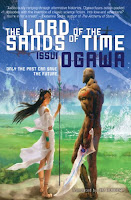 Editor: Nick Mamatas and Masumi Washington
Editor: Nick Mamatas and Masumi Washington
Publisher: Viz Media
ISBN: 9781421542232
Released: May 2012
I have been impatiently waiting for The Future Is Japanese: Science Fiction Futures and Brand New Fantasies from and about Japan, edited by Nick Mamatas and Masumi Washington, ever since the anthology was first announced. I already adore Viz Media’s Japanese speculative fiction imprint Haikasoru and will buy and read anything it publishes. However, I was particularly excited about The Future Is Japanese because it is Haikasoru’s first original publication. (I also hope that it isn’t the last.) I was thrilled when the book was finally released in 2012. The anthology collects thirteen stories from creators both East and West (primarily Japanese and American). All but two of the stories were being published for the first time. Just looking at the table of contents I was very pleased with what I saw. Most of the contributors to The Future Is Japanese are already award-winners in their own rights; those whose works with which I wasn’t already familiar I at least recognized by name. As an added bonus, the book’s cover illustration is by Yuko Shimizu, one of my favorite artists. The Future Is Japanese had a lot going for it from the very start.
After a foreword by Masumi Washington and an introduction by Nick Mamatas, The Future Is Japanese begins strongly with Ken Liu’s short story “Mono no Aware,” a meditation on impermanence wrapped in a science fiction tale of humanity’s survival at the edge of space. The next two stories were probably my least favorite in the collection although there were moments in each that I enjoyed tremendously. “The Sound of Breaking Up” by Felicity Savage starts as one story and ends up being an entirely different one. This frustrated me because I was more interested in the first. David Mole’s mecha tale “Chitai Heiki Koronbīn” ends too abruptly for my taste and seemed like it should be the introduction to a longer work. (Granted, one that I would like to read.) These are followed by “The Indifference Engine” by Project Itoh which explores war, hatred, and prejudice. Originally published in 2007, the story confirmed the fact that I want to read everything written by Itoh. The next story was one of my personal favorites in the anthology, “The Sea of Trees” by Rachel Swirsky, a haunting tale about death, ghosts, and letting go. Toh EnJoe’s story “Endoastronomy,” which follows next, has a philosophical and intellectual bent to it, something I enjoy about and have come to expect from his work.
The next selection, “In Plain Sight” by Pat Cadigan deals with the complications caused by artificial and augmented realities. The Future Is Japanese continues with “Golden Bread” by Issui Ogawa. I happen to be fond of Ogawa’s longer works and was not disappointed with his short story. Next is Catherynne M. Valente’s contribution, “One Breath, One Stroke” which is about yokai that live close to the human world. Written in a delightful but fragmented style, the work creates more of a mood rather than a cohesive story. Ekaterina Sedia’s near future and slightly melancholic tale “Whale Meat” follows. Next in the anthology is a selection from the extremely prolific Hideyuki Kikuchi. I actually preferred “Mountain People, Ocean People” over many of the other works of his that I have read. Following next is “Goddess of Mercy” by Bruce Sterling, one of the longer stories in the collection it is about the pirates and darkness that settle on Tsushima island after Japan is destroyed. The Future Is Japanese concludes with “Autogenic Dreaming: Interview with the Columns of Clouds” by TOBI Hirotaka. Originally published in 2009, the story won a Seiun Award in 2010. A complex story featuring a digitization project that has unexpected consequences, “Autogenic Dreaming” particularly appealed to my information science background.
As with most short story collections, how much a reader will enjoy each individual work in The Future Is Japanese will depend on personal preferences. Although I wasn’t blown away by the anthology, personally I found The Future Is Japanese to be a very satisfying read. The short story can be a difficult form to master, but even the works that I found problematic had their strong points. The stories do all tend to be serious in tone, but the collection covers a nice range of speculative fiction from fantasy to science fiction to horror. The Future Is Japanese also has a good balance between Western and Japanese authors. Appropriately enough for the anthology’s theme, even the Western works show Japanese influence, whether stemming from the writers’ personal interests or from the creators having lived in or visited Japan. Overall, The Future Is Japanese is a solid anthology that was well worth the wait.




